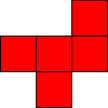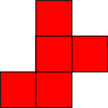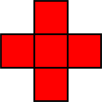Boxes, Cubes, and Nets
Previous math puzzles focused on polyominoes. This puzzle takes polyominoes into the third dimension.
Polyominoes are shapes made by attaching a certain number of squares of the same size so they line up along their edges. A polyomino can contain any number of squares, but shapes that use a fixed number of squares have a specific prefix that describes their number. Pentominoes are made of exactly five squares, hexominoes of six squares, and so forth. For more background about polyominoes and some intriguing polyomino puzzles, check out our Polyominoes and Polyomino Puzzles math puzzles.
Here are some sample pentominoes, and their names.
 Monomino |
 Domino |
 Tromino |
 Tetromino |
 Pentomino |
 Hexomino |
 |
There are several different ways to form each type of polyomino—the higher the number of squares, the more ways to form pentominoes with that many squares. In Polyominoes and Polyomino Puzzles, our math puzzles were concerned with finding all possible pentominoes, and with solving polyomino puzzles, jigsaw puzzles that use polyominoes as pieces to fill in a particular shape.
This month’s puzzle gives pentominoes and hexominoes a new dimension—literally. Suppose you take a cube-shaped box. Let’s start with one without a top, like the one shown here.
|
|
If you take a pair of scissors and carefully cut the box along all of its vertical edges, the shape can be flattened out to form a pentomino. This particular pentomino is sometimes called a cross pentomino or an X-pentomino because the five squares form a perfect symmetrical cross or X shape.
A flat shape that can be folded into a three-dimensional shape without cutting into it is called a net.
|
|
Puzzle 1
Here’s the first puzzle. You are to find all the different pentominoes that form nets for open-top cube boxes. Not all pentominoes are nets for cube boxes. For instance the I-shaped pentomino (right) cannot be folded into a box. Can you see why? (The squares marked "X" would overlap, and the result would be a square "tube" with no bottom or top.)
Your challenge: find all the different pentominoes that are nets for open-top cube boxes. How will you know when you’ve found them all? Well, there are 12 different pentominoes all together. (If you want to see them all, they can be found in the solution to the Polyominoes puzzle. If you want to find them all yourself, that’s fine too.) Some of these are nets; others are not. Your task is to decide which ones are the nets.
We recommend that you actually draw your pentominoes on graph paper, cut them out, and fold them to verify that they will indeed form an open box.
 |
 |
Finally, for every pentomino that cannot form a net for an open box, you should explain how you know it can’t be such a net.
Remember, two pentominoes may look different but still be the same shape if they are congruent to each other. Pentomino A in the figure below can be picked up, flipped over, and rotated so that it fits exactly on top of pentomino B. This is one way to show that they are congruent.
Puzzle 2
Your second challenge is to step up to hexominoes and nets for closed cubes. Remember, hexominoes are made from six attached squares. Find all the different hexominoes that are nets for a closed cube. One example is shown in the figure below. You can think of this hexomino as the X-pentomino with one added square. The added square folds over to close up the top of the cube.
Unfortunately, there are 35 different hexominoes. It would be tedious to find them all and prove which ones can and cannot be nets for cubes. However, there is a good shortcut that can save you a lot of trouble.
A net for a cube can only be made by adding a square to a pentomino that is a net for a net for an open-top cube box. Can you convince yourself that this is true? Take any pentomino that cannot form a net for a box. Can you find any way to add a square to it and make a net for a cube? Try it using the I-pentomino. We already know that it can’t form an open box. Can you add a square to it in any way that will allow it to fold into a cube?

Background
First, a couple of definitions. A polygon is a closed two-dimensional shape whose edges are straight lines that do not cross each other. A polyhedron is a closed three-dimensional shape whose faces are polygons.
Two-dimensional and three-dimensional geometry are often studied as if they were different subjects. In future puzzles, we study one way they are related—through the construction of nets, two-dimensional shapes made of polygons that fold up into polyhedrons.
This puzzle makes use of three other important mathematical ideas. The first of these is the concept of congruence, introduced above. Mathematically, two shapes are congruent if they have the same size and shape, regardless of their orientation. If you can pick up one of the shapes and rotate it, flip it over, and/or slide it so that it fits exactly on top of the other shapes, then the two shapes are congruent. This is one simple test for congruence. There are many others.
The second is the idea that you sometimes have to test to be sure whether two mathematical objects are the same or different. Just because two polyominoes look different, you can’t be sure they are different until you’ve picked one up and made sure it’s not congruent to the other. For polyominoes, congruence is the test—but mathematicians have many other tests they can use for different types of problems.
The third is the idea of finding all possible ways to solve a particular problem. This is a common type of problem in combinatorics. For example, find all the possible ways to arrange the numbers from 1 to N. Or for a more everyday example, a restaurant serves pizza with four different toppings: onions, mushrooms, sausages, and extra cheese. How many different types of pizzas can they make using 1, 2, 3, or 4 of the toppings? (Of course, a real restaurant would probably provide many more than four toppings.)
Combinatorics problems involving geometry can be much more complex. For example, if N is the number of faces in a polyhedron, there is no known rule or formula that can tell you how many different nets can be constructed for a polyhedron with N faces. (Mathematicians have worked out the exact number of nets for many different polyhedrons, but no general rule has ever been found.)
This content has been re-published with permission from SEED. Copyright © 2025 Schlumberger Excellence in Education Development (SEED), Inc.
Course:


